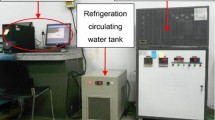Abstract
Building energy simulation is essential for most architectural design projects. Many models have been developed to predict the indoor air temperature and relative humidity as well as the building’s heating and cooling loads. However, in most building energy analysis the calculation of heat conduction through walls usually neglects the transport and storage of moisture in porous building materials, and the interaction between hygrothermal transfer and airflow inside the building. An accurate heat load (both sensible and latent load) determination requires a calculation of the coupled heat and moisture transfer in building envelopes and the hygrothermal interactions between the envelope and the environment. This paper evaluates the accuracy and the applicability of three thermal models in EnergyPlus (CTF—Conduction Transfer Function model, HAMT—Combined Heat and Moisture Transfer model, EMPD—Effective Moisture Penetration Depth model) for calculating moisture effects on building energy consumption in different climate conditions. The simulation results are compared with field measurements. The effects of different room infiltration rate on the accuracy of different models are also analyzed.
Similar content being viewed by others
References
Bonneau D, Rongere FX, Covalet D, Gauthier B (1993). Clim2000: Modular software for energy simulation in buildings. In: Proceedings of 3rd International IBPSA Building Simulation Conference, Adelaïde, Australia.
Crausse P (1983). Etude fondamentale des transfers couplés de chaleur et d’humidité en milieu poreux non saturé. PhD Thesis, Institut National Polytechnique de Toulouse. (in French)
Cunningham MJ (1988). The moisture performance of framed structures—A mathematical model. Building and Environment, 23: 123–135.
Cunningham MJ (1992). Effective penetration depth and effective resistance in moisture transfer. Building and Environment, 27: 379–386.
DOE-2 (1982). DOE-2 Engineers Manual. Available at http://www.doe2.com.
DesignBuilder (2014). DesignBuilder Simulation Manual. Available at http://www.designbuilder.co.uk/content/view/43/64.
EnergyPlus (2011). EnergyPlus Engineering Reference. Available at http://apps1.eere.energy.gov/buildings/energyplus/pdfs/engineer ingreference.pdf.
EnergyPlus (2013). EnergyPlus Weather Data. Available at: http://apps1.eere.energy.gov/buildings/energyplus/weatherdata_ about.cfm.
Grunewald J (2000). Documentation of the numerical simulation program DIM3.1, Vol 1: Theoretical fundamentals. Delphin4 program installation. Available at http://bauklimatik-dresden.de/ software.html.
Holm A, Künzel HM, Sedlbauer K (2003). The hygrothermal behaviour of rooms: Combining thermal building simulation and hygrothermal envelope calculation. In: Proceedings of 8th International IBPSA Building Simulation Conference, Eindhoven, Netherlands.
Hirsch JJ (2004). eQUEST—Quick Energy Simulation Tool Tutorial.
Kari B, Perrin B, Foures JC (1992). Modelisation macroscopique des transferts de chaleur et d’humidité dans des materiaux du bailment. Materials and Structures, 25: 482–489. (in French)
Kerestecioglu A, Swami M, Kamel A (1990). Theoretical and computational investigation of simultaneous heat and moisture transfer in buildings: “Effective penetration depth” theory. ASHRAE Transactions, 96(1): 447–454.
Künzel HM (1995). Simultaneous heat and moisture transport in building components: One- and two-dimensional calculation using simple parameters. PhD Thesis, Universität Stuttgart, Germany.
Luikov AV (1975). Systems of differential equations of heat and mass transfer in capillary-porous bodies. International Journal of Heat and Mass Transfer, 18: 1–14.
Mendes N, Winkelmann FC, Lamberts R, Philippi PC (2003). Moisture effects on conduction loads. Energy and Buildings, 35: 631–644.
Nguyen AT, Reiter S, Rigo P (2014). A review on simulation-based optimization methods applied to building performance analysis. Applied Energy, 113: 1048–1058.
Pedersen CR (1990). Combined heat and moisture transfer in building constructions. PhD Thesis, Technical University of Denmark, Denmark.
Phillip JR, de Vries DA (1957). Moisture movement in porous materials under temperature gradients. Eos, Transactions American Geophysical Union, 38: 222–232.
Rode C, Grau K (2003). Whole building hygrothermal simulation model. ASHRAE Transactions, 109(1): 572–582.
Qin M, Belarbi R, Aït-Mokhtar A, Allard F (2009). Simulation of coupled heat and moisture transfer in air-conditioned buildings. Automation in Construction, 18: 624–631.
Qin M, Walton G, Belarbi R, Allard F (2011). Simulation of whole building coupled hygrothermal-airflow transfer in different climates. Energy Conversion and Management, 52: 1470–1478.
TRNSYS (2012). Transient System Simulation program, Volume 6: Multizone Building modeling with Type56 and TRNBuild. Solar Energy Laboratory, University of Wisconsin-Madison.
Van der Kooi J (1971). Moisture transport in cellular concrete roofs. PhD Thesis, Eindhoven University of Technology, the Netherlands.
Woods J, Winkler J, Christensen D (2013). Evaluation of the effective moisture penetration depth model for estimating moisture buffering in buildings. National Renewable Energy Laboratory, USA.
Woloszyn M, Rusaouen G, Covalet D (2004). Whole building simulation tools: Clim2000. Publication A41-T1-F-04-3. Presentation for IEA Annex 41 meeting, Zurich, Switzerland.
Woloszyn M, Rode C (2008). Tools for performance simulation of heat, air and moisture conditions of whole buildings. Building Simulation, 1: 5–24.
Yan D, Xia J, Tang W, Song F, Zhang X, Jiang Y (2008). DeST—An integrated building simulation toolkit Part I: Fundamentals. Building Simulation, 1: 95–110.
Author information
Authors and Affiliations
Corresponding author
Rights and permissions
About this article
Cite this article
Qin, M., Yang, J. Evaluation of different thermal models in EnergyPlus for calculating moisture effects on building energy consumption in different climate conditions. Build. Simul. 9, 15–25 (2016). https://doi.org/10.1007/s12273-015-0263-2
Received:
Revised:
Accepted:
Published:
Issue Date:
DOI: https://doi.org/10.1007/s12273-015-0263-2




